Getting the message
How employees use and feel about email
Email has grown into a full-blown social science since its humble origins in 1996. It’s likely a part of your work life — whether you’re sending email, receiving it, reading it, or flat-out ignoring it. In fact, one study suggests office employees spend at least 78% of their eight-hour workday just checking email.To find out more about our growing inboxes, we surveyed 2,000 workers in the United States who use email and asked them about their email habits, preferences, and pet peeves. We’ve also outlined some best practices and email clutter-busters.
Employee email trends
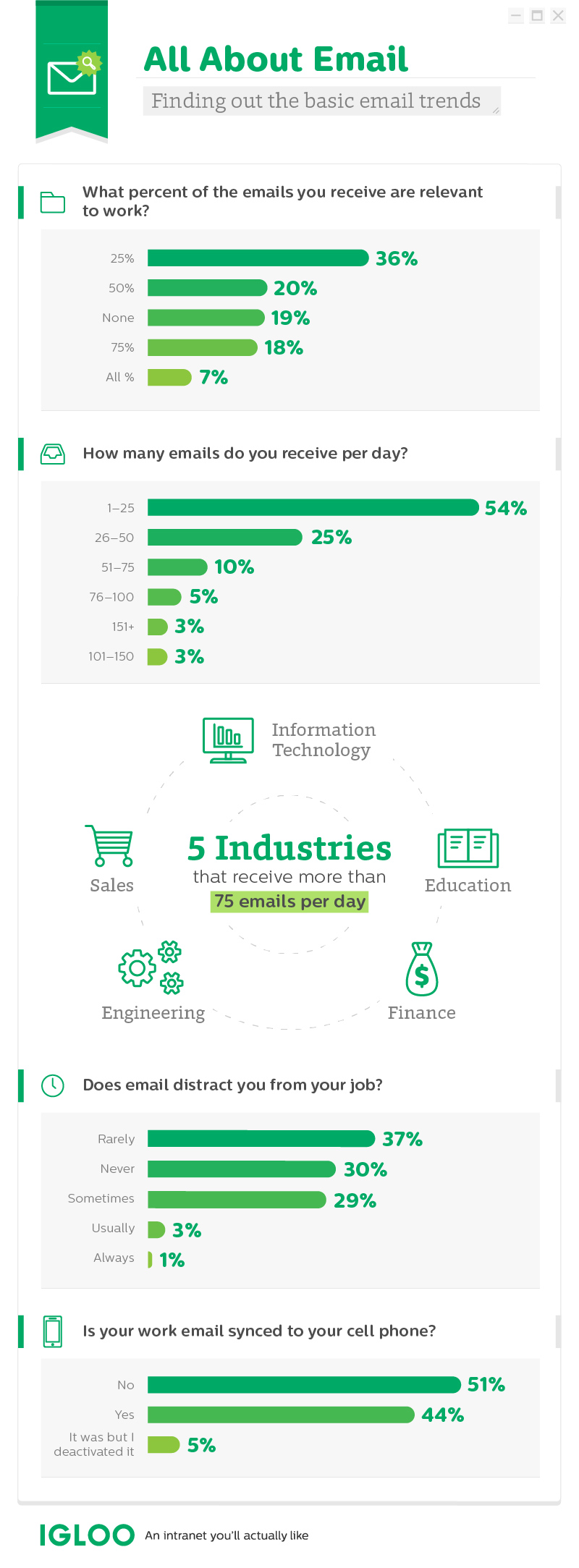
When it comes to communicating during the workday, clearly email is a must. More than half of workers receive one to 25 emails per day, and another quarter get between 26 and 50. Amazingly, when we asked how many of those daily emails are relevant to work, three-quarters of respondents said half of their emails (or even fewer) are relevant.
Although our respondents don’t find email distracting, a recent study from the University of California, Irvine, revealed the opposite: External distractions (including email and phone calls) mean the average employee spends only 11 minutes on a task before being interrupted. Experts suggest keeping a list of information and sending it all at once, rather than emailing one question or talking point at a time.
Email Clutter-Buster: Take a tip from LinkedIn, which recently revamped its notoriously spammy email strategy. For every 10 emails you might have sent, instead send four. For those remaining six communications, look for opportunities to approach team members in other ways – face-to-face chats, instant messaging, and shared team calendars are just a few workable alternatives.
Employee email pet peeves
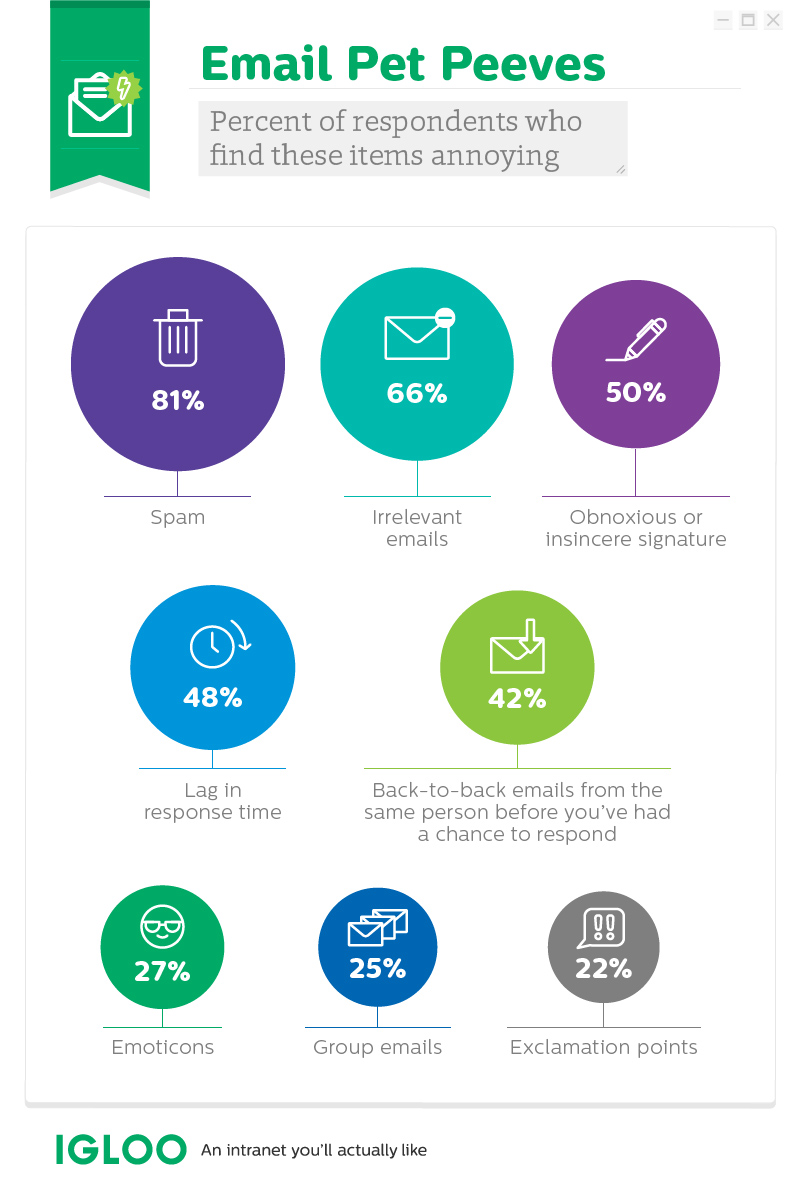
While some emails are important, many others make employees cringe. What gets on our respondents’ nerves the most?
Obnoxious or insincere signatures bother nearly half of the people surveyed. Bloomberg Businessweek agrees. It’s time to ditch the 18th-century sign-offs: “Best wishes” (or “Best [anything]”) as well as “Warmest regards” and “Sincerely yours.”
Nearly 7 in 10 despise irrelevant emails. Others (42%) say a barrage of instant message–style emails are just as offensive.
Email Clutter-Busters:
- Start private messaging. Let your company’s operations manager know about team communication softwares. Employees can use them to easily share quick bits of information without overloading inboxes. With some services, administrators can sort employees by department, so the 25-percenters who hate group email can part ways with “reply-all” threads.
- Emote, don’t emoji. The Harvard Business Review suggests stating your emotional intentions rather than softening a blow with a Band-Aid emoji. Consider a compliment sandwich instead (i.e., words of praise before and after critical feedback). You may please nearly a quarter of your co-workers with this strategy.
- Sign off simply. We’ve learned sappy send-offs are never the answer. So what should you write instead? Experts say nothing. Let your punctuation do the talking (and no, we don’t mean excessive exclamation points). Digital-age readers prefer concise communication, well-wishes excluded.
Employees open up about email
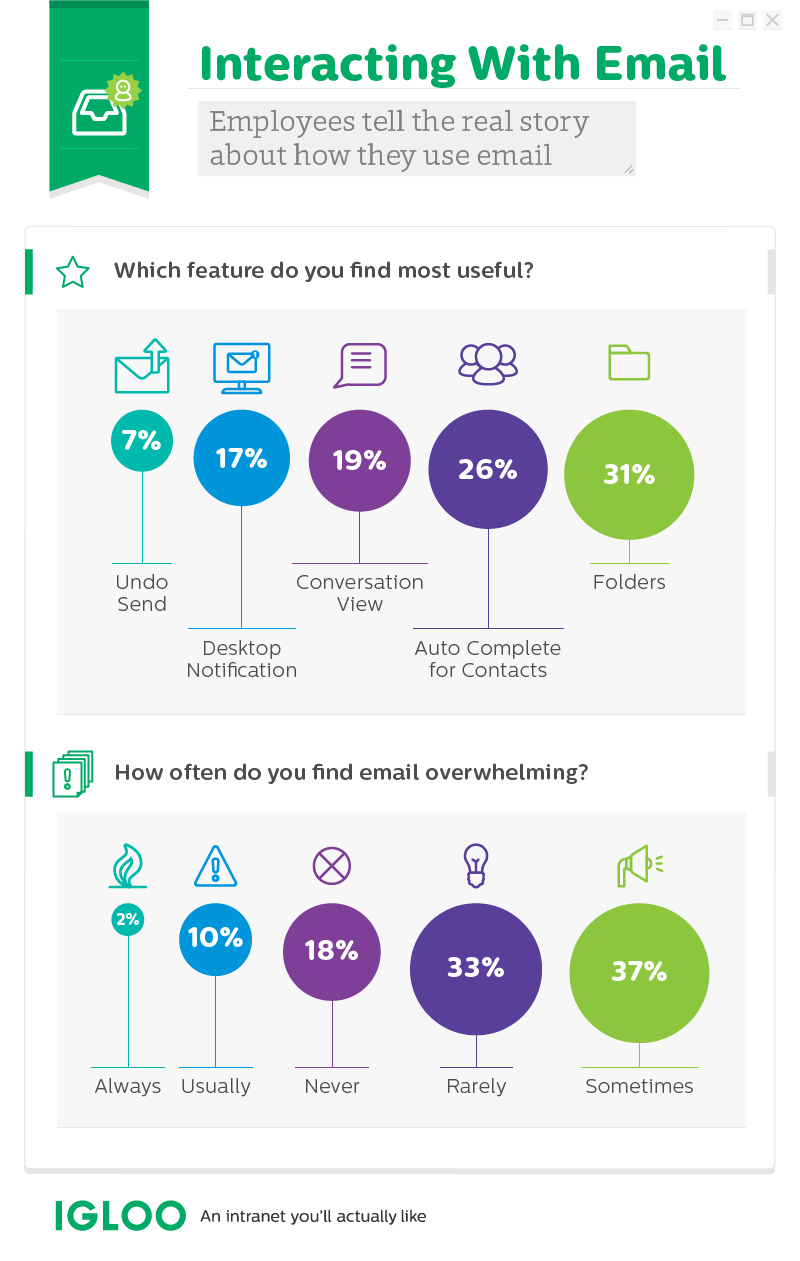
Email is mostly overwhelming, according to half of workers, and our instant-alert culture isn’t helping. Psychologists say “push notifications” only aggravate our email anxieties. Although 17% may find desktop notifications helpful, it turns out they could be doing more harm than good.
Email Clutter-Buster: If possible, communicate your expectations for email response time with your co-workers and set specific times of the day to prune your inbox. Are email notifications a must for your memo-heavy workplace? Simply turning off the sound on your email notifications may help reduce your tech tension.
Read before deleting
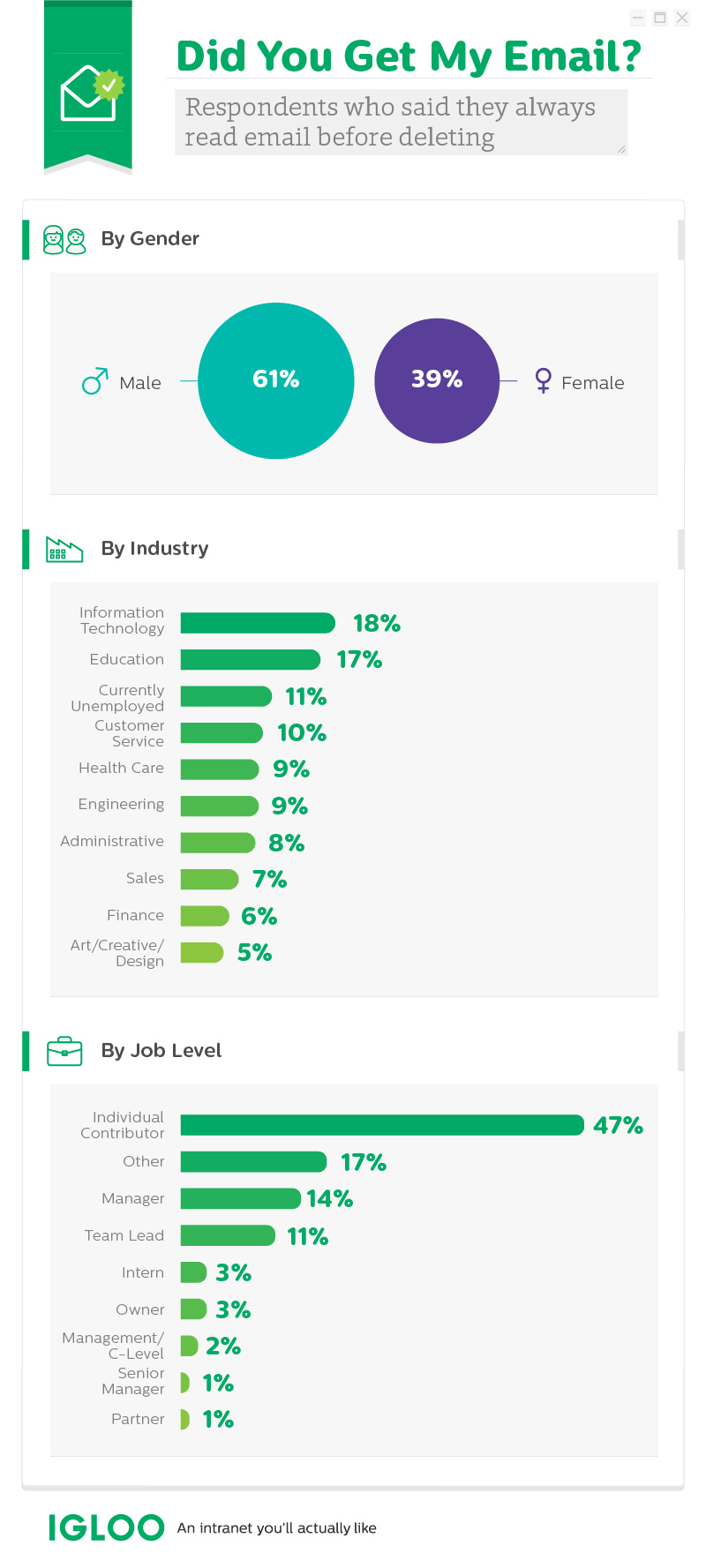
People who work in IT are the most dutiful readers of email: Nearly 1 in 5 reads every one.Education professionals are not far behind. Maybe it’s all those support tickets and bogus bonus emails.
How do people’s positions affect their likelihood of reading every email? At the top, nearly half of individual contributors report they open every message. On the other hand, volunteers are least likely to read every email. Surprisingly, people who hold high-level positions, including various managers, vice presidents, and partners, also admit they’re unlikely to read all their messages.
Email Clutter-Buster: How can you increase the odds of a recipient’s reading (and responding to) your email? Make sure it’s short and to the point, craft a clear subject line, format it for easy skimmability, and be sure your request is clear and specific.
Preferred communication methods
It isn’t always easy sitting face-to-face with a higher-up, and email can help alleviate some of that stress. But going the digital route can leave your message open to misinterpretation.
When is email the preferred communication method? When people are reaching out to a company owner or client. As for direct supervisors, co-workers, and friends, more people prefer face-to-face talks.
Interestingly, email is the second-favorite method for communicating with supervisors and co-workers. Perhaps these workers would rather use emojis than concrete emotional language?
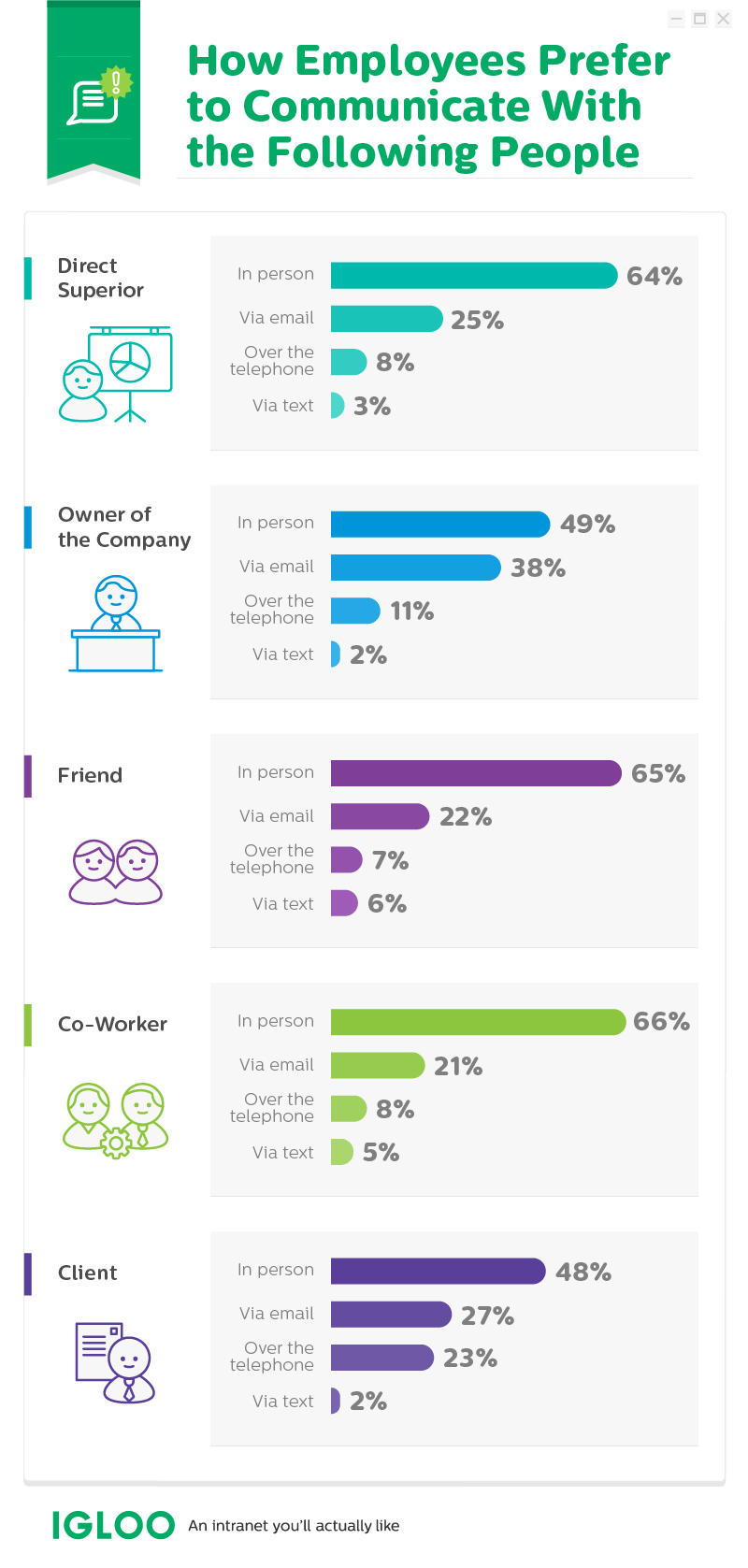
Key(mail) takeaways
Want to make email work harder for you? Get rid of that embarrassing email address from 20 years ago, and brush up on your messaging etiquette. Above all, write with purpose. Consider the following email best practices:
- Respond to email promptly even if you don’t have an answer (“I’ll get back to you next week with the answer” should suffice).
- Always craft a thoughtful response rather than dashing off “OK.”
- Skip stream-of-consciousness messages in favor of to-the-point missives. Similarly, avoid “reply-all” emails when possible.
- Opt for a platform-specific strategy. If you desire a quick, collaborative response, choose instant messaging. Need to send info about your company’s Fourth of July barbecue? Start an internal company blog with a comment thread.
- Consider using a file sharing system. It allows several people to access a single document at once, eliminating the need to email different versions back and forth.
- Keep subject lines short. MailChimp recommends 50 or fewer characters. Forwarding an email from an untidy sender? Clean up the subject line yourself.
Methodology
Survey Monkey was used to host our survey while it was distributed through Amazon Mechanical Turk to gather responses. 2,000 U.S. residents took the survey.
Sources
- http://www.mckinsey.com/industries/high-tech/our-insights/the-social-economy
- http://www.ics.uci.edu/~gmark/CHI2005.pdf
- http://www.businessinsider.com/email-etiquette-rules-every-professional-needs-to-know-2016-1
- https://medium.com/life-tips/how-to-get-a-busy-person-to-respond-to-your-email-52e5d4d69671#.qi4fwe75j
- http://money.usnews.com/money/blogs/outside-voices-careers/2014/07/21/5-lesser-known-email-etiquette-rules-you-might-be-breaking
- http://www.huffingtonpost.com/entry/check-work-email-hours-survey_us_55ddd168e4b0a40aa3ace672
- http://www.bloomberg.com/news/articles/2015-06-02/the-best-e-mail-signature-is-actually-the-worst
- https://hbr.org/2015/04/the-dos-and-donts-of-work-email-from-emojis-to-typoshttp://kb.mailchimp.com/campaigns/previews-and-tests/best-practices-for-email-subject-lines
- http://www.nytimes.com/2015/07/29/business/linkedin-notorious-for-sending-too-many-emails-cuts-back.html?_r=0
Learn how an intranet can help
your company
